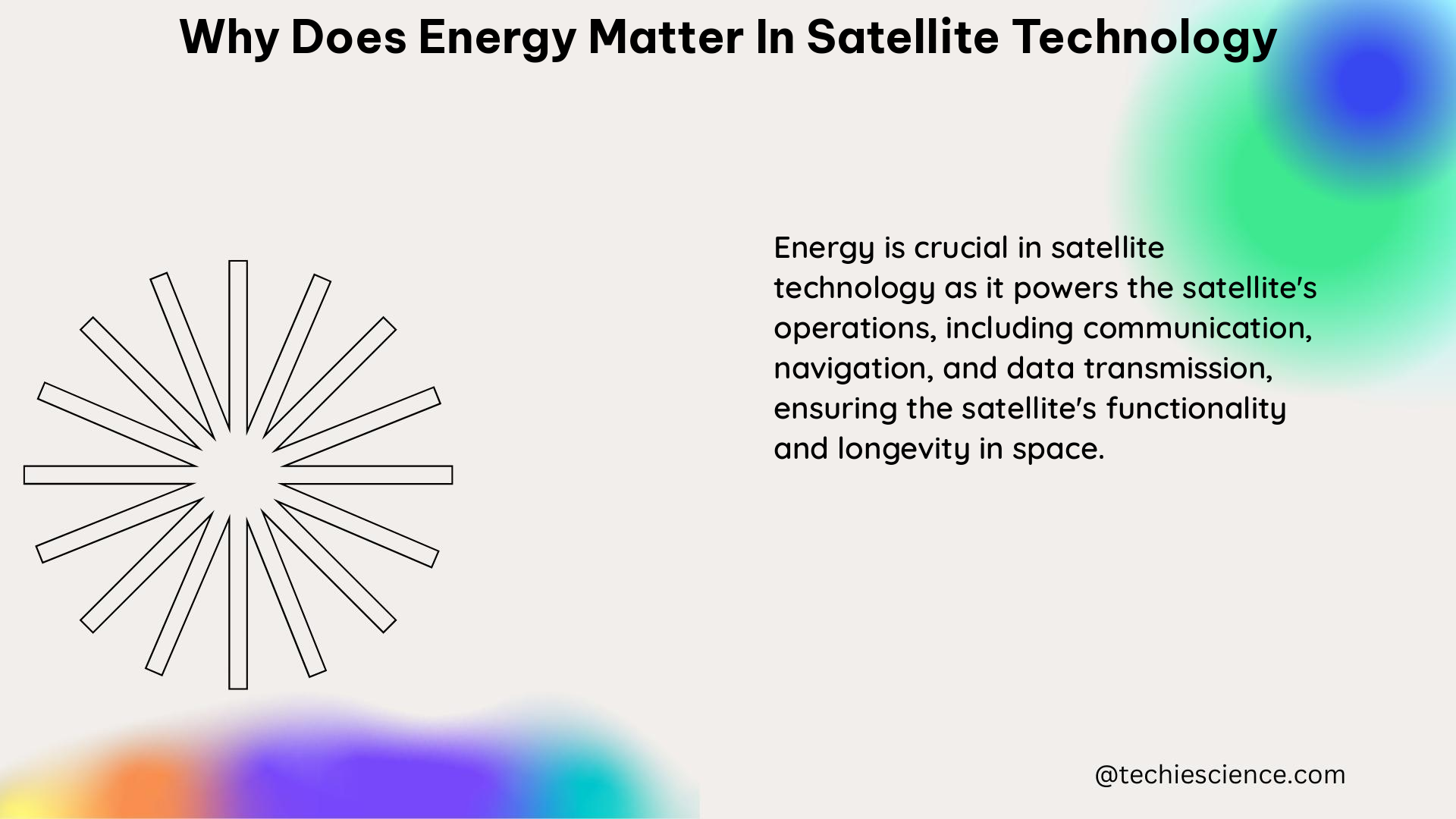Energy is a critical factor in satellite technology, as it powers the various systems and operations that enable satellites to function effectively. Satellites require a significant amount of energy to operate their communication, navigation, and sensor systems, as well as to transmit the data they collect back to Earth. Additionally, the energy used in satellite operations can have a significant impact on the environment, making it an important consideration in the design and development of satellite technology.
Powering Satellite Systems
Satellites require a substantial amount of power to operate their various systems, including communication, navigation, and sensors. The power requirements for a satellite can vary depending on its size, complexity, and the specific tasks it is designed to perform.
Power Generation
Satellites typically generate their power using one or more of the following methods:
-
Solar Panels: Solar panels are the most common power source for satellites, as they can convert sunlight into electrical energy. The size and efficiency of the solar panels used on a satellite can have a significant impact on the amount of power available.
-
Batteries: Satellites often use batteries to store energy generated by their solar panels, which can be used to power the satellite during periods when it is not exposed to sunlight, such as when it is in the Earth’s shadow.
-
Fuel Cells: Some satellites use fuel cells, which generate electricity through a chemical reaction between hydrogen and oxygen, as a power source.
-
Nuclear Reactors: In some cases, satellites may use nuclear reactors to generate power, particularly for missions that require a high level of power or operate in environments where solar power is not practical.
Power Management
Effective power management is crucial for satellite operations, as the available power must be carefully allocated to the various systems and operations. This often involves the use of power-saving modes, load-shedding strategies, and other techniques to ensure that the satellite’s power supply is used efficiently.
Data Collection and Transmission

Satellites are equipped with a variety of sensors, such as cameras, radar, and lidar, which are used to collect data about the Earth’s surface, atmosphere, and other phenomena. These sensors require energy to operate, and the amount of energy required can vary depending on the type of sensor and the frequency of data collection.
Sensor Power Requirements
The power requirements for satellite sensors can be significant, with some sensors requiring hundreds of watts or more to operate. For example, the Thermal Infrared Sensor-2 (TIRS) on the Landsat-8 satellite requires 180 watts of power to operate, and it can scan a ground swath of 185 kilometers (115 miles) while providing a 16-day coverage cycle of the Earth’s surface.
Data Transmission
In addition to the power required for data collection, satellites also require energy to transmit the data they collect back to Earth. This can involve the use of high-power transmitters and antennas, which can further increase the energy demands of the satellite.
Satellite Data for Energy Applications
Satellite data can be used for a variety of energy-related applications, such as tracking methane emissions, monitoring wind speeds, and predicting energy demand. These applications can have a significant impact on the development and deployment of sustainable energy technologies.
Methane Emission Tracking
Satellite data can be used to track the volume of gas flared at onshore and offshore oil and gas exploration sites, which can help reduce greenhouse gas emissions and support the integration of reliable clean energy sources.
Wind Speed Monitoring
Satellite data can also be used to monitor wind speeds, which can be valuable for the development and deployment of wind energy technologies.
Energy Demand Prediction
Satellite data can be used to predict energy demand, which can help energy providers plan and optimize their operations to meet the changing needs of their customers.
Satellite Operations and Big Data
Satellite operations can also be a significant source of big data, as the vast amounts of data collected by satellites can place significant demands on storage and computing resources.
Data Generation and Storage
For example, the Aqua satellite generates approximately 2,000 terabytes of data over its expected 6-year design life period, with an average data rate of 89 gigabytes per day. This data must be stored and processed, which requires a significant amount of energy.
Data Processing and Analysis
The processing and analysis of satellite data can also be energy-intensive, as it often requires the use of powerful computing resources and advanced algorithms.
Conclusion
In summary, energy is a critical factor in satellite technology, as it powers the various systems and operations that enable satellites to function effectively. From powering satellite systems and data collection and transmission to using satellite data for energy applications and managing the big data generated by satellite operations, energy is a fundamental component of satellite technology. Understanding the energy requirements and challenges associated with satellite technology is essential for the continued development and advancement of this field.
References:
1. Satellite Data Applications for Sustainable Energy Transitions. Frontiers in Sustainable Energy, 2022.
2. Information Could Be the Fifth State of Matter, Proving We Live in a … Popular Mechanics, 2022.
3. Satellite Technology for Quantifying Methane Emission and Flared gas, and Aiding Reliable Clean Energy Integration. Sais-Isep, 2020.
4. Integration of satellite remote sensing data in ecosystem modelling: progress, challenges and prospects. Journal of Ecology, 2018.
5. Transforming Energy into Imagery: How Satellite Data Becomes Stunning Views of Earth. NOAA, 2020.

The lambdageeks.com Core SME Team is a group of experienced subject matter experts from diverse scientific and technical fields including Physics, Chemistry, Technology,Electronics & Electrical Engineering, Automotive, Mechanical Engineering. Our team collaborates to create high-quality, well-researched articles on a wide range of science and technology topics for the lambdageeks.com website.
All Our Senior SME are having more than 7 Years of experience in the respective fields . They are either Working Industry Professionals or assocaited With different Universities. Refer Our Authors Page to get to know About our Core SMEs.